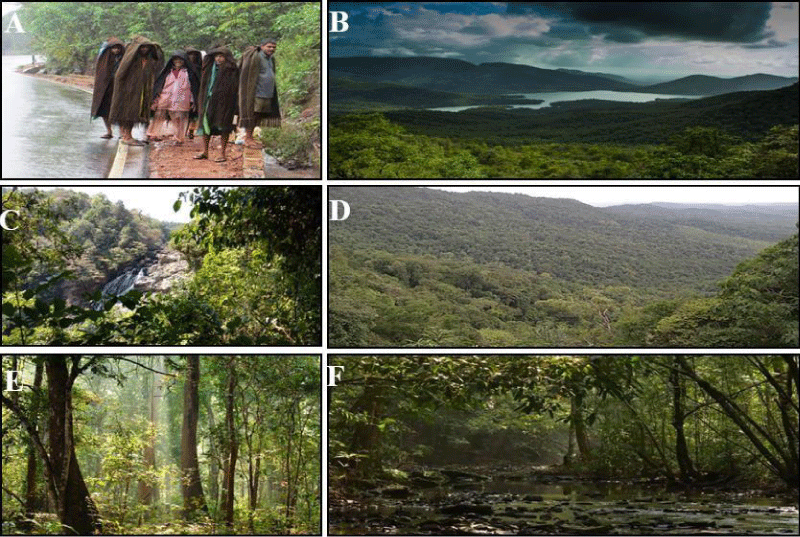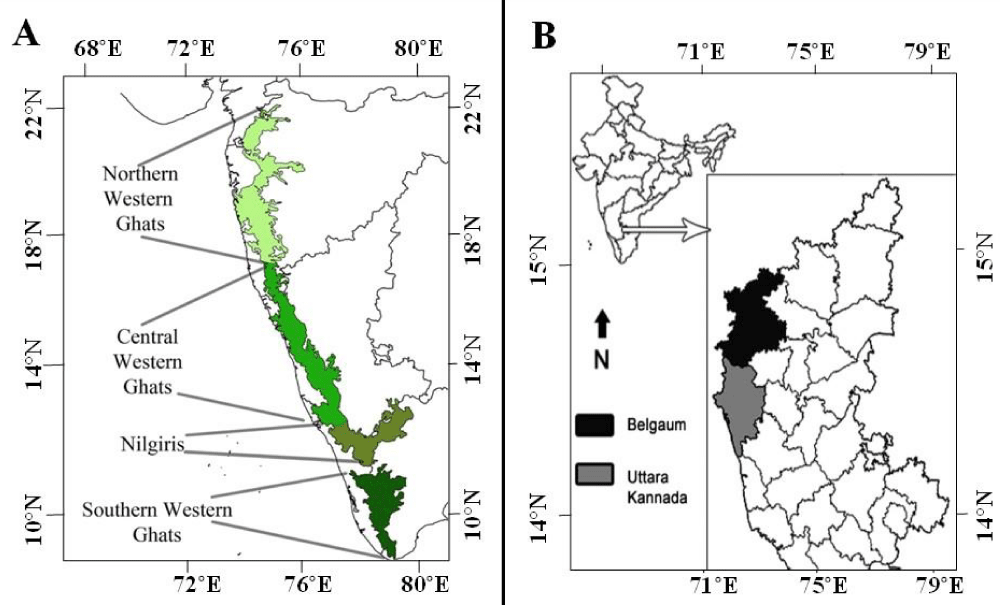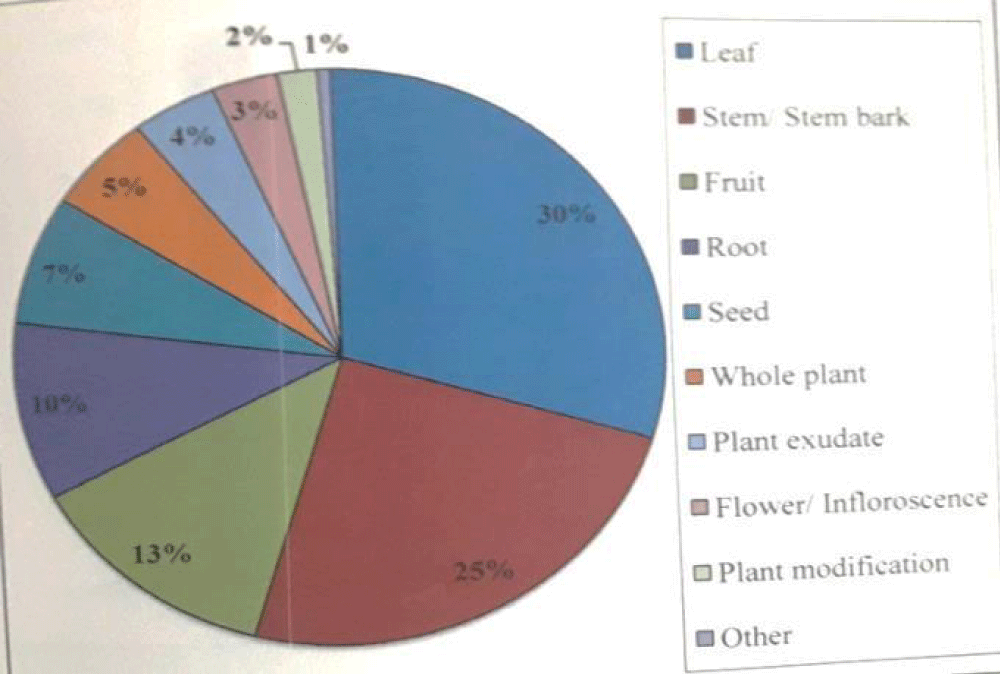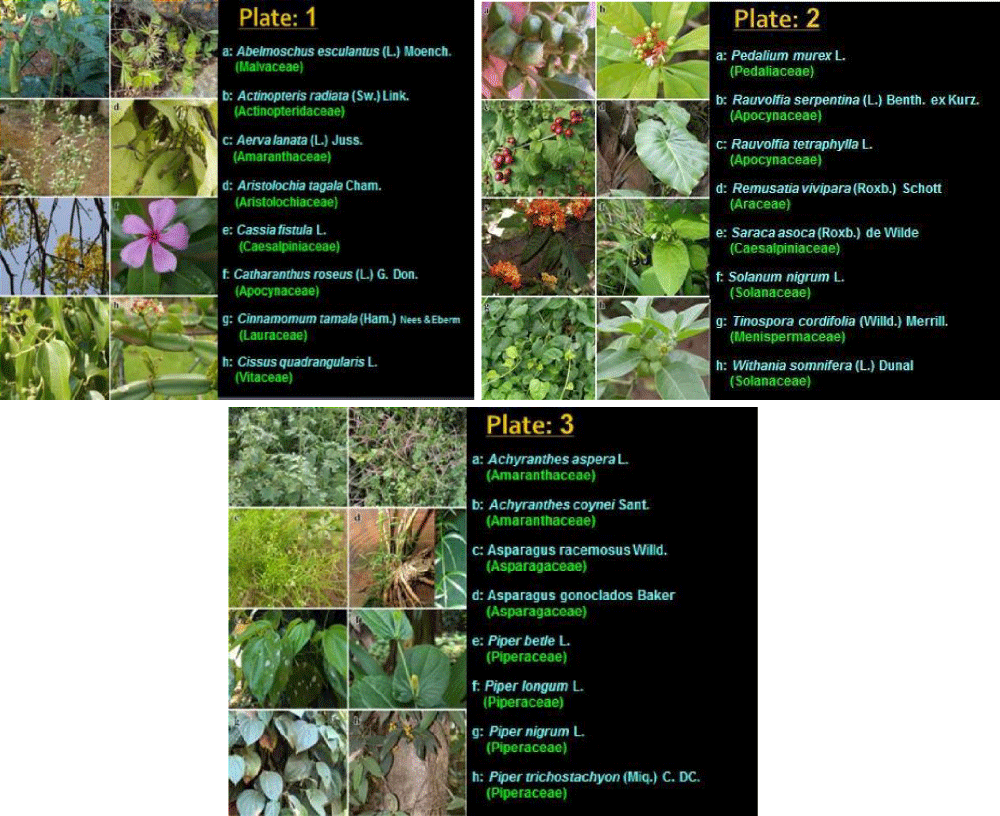More Information
Submitted: July 11, 2023 | Approved: August 11, 2023 | Published: August 14, 2023
How to cite this article: Hurkadale PJ, Bidikar CM. Ethno-Medicinal Plants from the North-Central Western Ghats of India for Alternative Health Care. J Plant Sci Phytopathol. 2023; 7: 076-080.
DOI: 10.29328/journal.jpsp.1001109
Copyright License: © 2023 Hurkadale PJ, et al. This is an open access article distributed under the Creative Commons Attribution License, which permits unrestricted use, distribution, and reproduction in any medium, provided the original work is properly cited.
Keywords: Ethnomedicine; Ethnomedicinal practices; Traditional medicine; Bio-cultural diversity; Herbal drug formulations; Conservation; Sustainable utilization
Ethno-Medicinal Plants from the North-Central Western Ghats of India for Alternative Health Care
Pramod J Hurkadale* and Chaitrali M Bidikar
Department of Pharmacognosy, KLES College of Pharmacy, KLE Academy of Higher Education and Research, J. N. Medical College Campus, Belagavi- 590 010, Karnataka, India
*Address for Correspondence: Dr. Pramod J Hurkadale, Professor, Department of Pharmacognosy, KLES College of Pharmacy, KLE Academy of Higher Education and Research, J. N. Medical College Campus, Belagavi- 590 010, Karnataka, India, Email: [email protected]
Ethnomedicine, synonymous with traditional medicine, is a crucial healthcare system practiced by various ethnic groups worldwide, especially among those with limited access to modern Western medicine. This study explores the rich bio-cultural diversity of the North Central Western Ghats in Karnataka, India, which harbors diverse ethnomedicinal practices. The region's tropical forests are home to an extensive array of plant species, with over 600 endemic to southern India and 95 exclusively endemic to Karnataka. The research focuses on documenting and analyzing the traditional knowledge of local communities regarding the use of plants for treating various human diseases. However, this task presents significant challenges and requires collaborative efforts from the government, NGOs, and Herbal Drug Companies. Over the last decade, ethnomedicinal studies have seen a rise, but there is still limited understanding of ethnomedicine's role in the traditional healthcare system in India. The forests of North Central Western Ghats, including Agumbe, Arbail Ghat, Chorla Betta, and others, exhibit a combination of deciduous and evergreen vegetation. These forests hold a variety of medicinal plants, adding to the region's bio-cultural richness. Scientific validation of the locally used ethnomedicinal plants further supports the development of herbal drug formulations with the support of the Ministry of Ayush, enabling the conservation and sustainable utilization of threatened and endangered species. The study emphasizes the importance of preserving traditional healers' knowledge and promoting collaboration for the preservation of ethnomedicinal practices in the region.
Ethnomedicine is practiced by various ethnic groups all over the globe those who have no access or with little access to other systems of medicine or western medicines that are compared with traditional medicine that are based on bioactive compounds in plants and animals. Ethnomedicine is sometimes used as a synonym for traditional medicine [1-4]. The North Central Western Ghats in India comprise rich bio-cultural diversity and are also home to varied ethnomedicinal practices. The certification and analysis of traditional knowledge regarding the practice and use of plants in the treatment of various human diseases are herculean tasks of which Government, NGOs, and Herbal Drug Companies are a part. The survey on the relationship between humans and nature has made it conceivable to realize the undercurrent existence of the communities and the bionetwork in which they inhabit together. Over the last decade, there has been a rise in ethnomedicinal studies, but still very little is known about the use of ethnomedicine in the traditional healthcare system in India. The traditional system is unique and undeniably important cultural ingredients which use varieties of plant extracts, traditional knowledge, and belief system for treatment as well as prevention of various diseases and ailments [5-11].
Karnataka is fortunate with some of the most splendid tropical forests of the Indian subcontinent. The state is endowed with varieties of forest vegetation with an enormous diversity of species the floral diversity is so wide and varied that in some districts, all types of forest from wet evergreen to dry thorn forests are encountered within a crow-fly distance of less than 100 km. About 60% of Karnataka’s forests are situated in the Western Ghats, one of the mega biodiversity hotspots of the world. The remaining forests situated in the Eastern Plains - although these have limited coverage - exhibit a high degree of plant diversity including varieties of medicinal plants. The total number of flowering plants (angiosperms) so far recorded in Karnataka is about 4,700 species belonging to 1,512 genera under 189 families. Out of these, over 600 species are endemic to southern India and 95 are exclusively endemic to Karnataka (Figure 1) [3,6,9,10,12].
Figure 1: Forests in the North Central Western Ghats of Karnataka Region. Agumbe, Chorla Betta, Arbail Ghat, Dandeli, Devimane Betta and Yellapur Kaadu.
The forests of Karnataka are primarily deciduous and evergreen. Deciduous forests have a preponderance of deciduous trees, whereas evergreen forests are dominated by evergreen trees. Deciduous trees completely shed their leaves for some time during the year; they have a distinct period of leaflessness ranging from a few days to a few months. In tropical deciduous forests, leaf fall is primarily determined by the reduction of water availability in the soil. Evergreen trees also shed their leaves but not all at the same time; they do not become leafless during any part of the year. In the driest parts of Karnataka, as also in the highly degraded forests of the state, there is a predominance of thorny species. The appearance of thorny elements is reflective of nature’s adaptation to harsher conditions, where there is a need for conservation of energy and water, besides warding off herbivorous intruders (Figure 2) (Table 1) [13-15].
Figure 2: Forests of North Central Western Ghats, Karnataka Region, featuring. A. Sholas, B. Evergreen and C. Mangroves.
| Table 1: Types of Forests. | |
| Types of Forest | |
| Southern tropical wet evergreen | Riparian fringing forest |
| Southern hilltop tropical evergreen | Dry teak-bearing forest |
| Southern subtropical hill | Very dry teak forest |
| South Indian subtropical hill | Dry Teak forest |
| Myristica swamps | Southern dry mixed deciduous |
| Cane brakes | Boswellia |
| Wet Bamboo brakes | Hardwickia |
| Ochlandra reed brakes | Dry bamboo brake |
| Pioneer Euphorbiaceous scrub | Dry deciduous scrub |
| Mangrove | Dry savannah forest |
| Southern tropical semi-evergreen | Dry tropical riverain (fringing) |
| West Coast evergreen Dipterocarpus | Secondary dry deciduous |
| Lateritic semi-evergreen | Euphorbia scrub |
| Moist bamboo brakes | Lateritic scrub |
| Southern tropical moist deciduous teak | Dry grassland |
| Very moist teak | Southern moist mixed deciduous |
| Moist teak | Southern thorn scrub |
| Slightly moist teak forest | Southern Euphorbia scrub |
The documentation of locally used ethnomedicinal plants of the above-mentioned areas of the Western Ghats resulted in further scientific validation to prove their efficacy and further develop herbal drug formulations in the codified forms with the support of CCRAS, Ministry of Ayush that can emphasize these traditional healers and growers for conservation along with the sustainable utilization of threatened and endangered species (Figure 3) [16-21].
Figure 3: A. Western Ghats Region of India showcasing its forested areas, B. Map highlighting Belagavi and Uttara Kannada Districts within the Western Ghats.
In the lush landscapes of Karnataka's Western Ghats, where rich bio-cultural diversity thrives, a treasure trove of traditional health practices and ethnomedicine awaits exploration. Amidst the dense tropical forests and varied flora, several alternative medicines and complementary therapies have been practiced for generations, offering unique insights into the healing potential of nature. Rooted in ancient Indian wisdom, Ayurveda is a holistic system that seeks to balance the body, mind, and spirit. With its emphasis on herbal remedies, therapeutic diets, yoga, and meditation, Ayurveda plays a crucial role in traditional health care in the region. Healing from Tamil Nadu but widely practiced in Karnataka's Western Ghats, Siddha medicine is known for its use of natural substances like herbs, minerals, and animal products to address health issues and promote well-being (Figure 4) [22-26].
Figure 4: Percentage of ethnomedicinal plant parts used in traditional healing practices.
Influenced by Greek medicine, Unani emphasizes the balance of four humours and utilizes herbal medicines and dietary modifications to maintain health and treat ailments. Based on the principle of "like cures like," homeopathy utilizes highly diluted substances to stimulate the body's healing response. It has gained popularity as an alternative therapy in the region. With a focus on natural healing methods, naturopathy incorporates herbal medicine, hydrotherapy, and lifestyle adjustments to support the body's innate ability to heal. In harmony with the serene surroundings of the Western Ghats, yoga and meditation are integral components of traditional health practices, promoting physical and mental well-being. Indigenous communities in the region have an intimate knowledge of local plants and their medicinal properties, utilizing herbal remedies passed down through generations (Figure 5). Traditional healers, often regarded as custodians of cultural heritage, play a vital role in ethnomedicine. They employ a mix of rituals, prayers, and plant-based remedies for healing purposes [27-35].
Figure 5: List of Medicinal plants selected for scientific validation studies.
As modernization encroaches upon these pristine landscapes, efforts must be made to preserve and integrate traditional health practices with scientific validation. Collaborations between governmental bodies, NGOs, and herbal drug companies can facilitate the documentation, analysis, and conservation of traditional knowledge while promoting the sustainable utilization of threatened plant species. In doing so, Karnataka's Western Ghats can continue to be a bastion of traditional health care, offering a holistic approach to well-being that cherishes the harmony between humans and the natural world [36-41].
Ethnomedicine plays a crucial role in the healthcare practices of various ethnic groups around the world, particularly in regions where access to other medical systems, such as Western medicine, is limited. It is often based on traditional knowledge and the use of bioactive compounds from plants and animals. The North Central Western Ghats region in India is rich in both bio-cultural diversity and ethnomedicinal practices. The certification and analysis of traditional knowledge related to ethnomedicine is a challenging task, but various stakeholders, including the government, NGOs, and Herbal Drug Companies, are actively involved in the process. The relationship between humans and nature is deeply intertwined in these communities, and the survey of such interactions has revealed the importance of ethnomedicine in their daily lives. Karnataka, specifically, is blessed with diverse and lush tropical forests, showcasing an incredible variety of plant species, including numerous medicinal plants. The state's forests, both deciduous and evergreen, hold great significance in terms of ecological and medicinal importance. The Western Ghats, in particular, stands out as one mega biodiversity hotspot in the world, harbouring unique plant species, some of which are endemic to the region. The documentation of ethnomedicinal plants in the Western Ghats has led to scientific validation, which strengthens their potential for herbal drug formulations. Collaborative efforts with organizations like CCRAS and the Ministry of Ayush have helped emphasize the importance of traditional healers and growers, leading to the conservation and sustainable utilization of threatened and endangered plant species. Overall, the study and promotion of ethnomedicine are essential for preserving traditional knowledge, promoting biodiversity conservation, and potentially discovering new treatments for human ailments. It is vital to strike a balance between modern scientific approaches and the valuable wisdom inherited from generations of indigenous communities.
- ICMR- National Institute of Traditional Medicine, Belagavi
- Western Ghats Kokum Foundation, Goa
- Shri BMK Ayurveda Mahavidyalaya, Belagavi
- Society for Ethnopharmacology, Belagavi Chapter
- Indian Society of Pharmacognosy, Karnataka References.
- Acharya D, Shrivastava A. Indigenous herbal medicines: Tribal formulations and traditional herbal practices. Aavishkar Publishers Distributor. 2008.
- Bennett BC, Prance GT. Introduced plants in the indigenous pharmacopoeia of Northern South America. Economic Botany. 2000; 54(1): 90-102.
- Byg A, Balslev H. Diversity and use of palms in Zahamena, eastern Madagascar. Biodiversity and Conservation. 2001; 10(6): 951-970.
- Vandebroek I, Calewaert JB, De Jonckheere S, Sanca S, Semo L, Van Damme P, De Kimpe N. Use of medicinal plants and pharmaceuticals by indigenous communities in the Bolivian Andes and Amazon. Bulletin of the World Health Organization. 2008; 86(10): 759-760.
- Fabricant DS, Farnsworth NR. The value of plants used in traditional medicine for drug discovery. Environ Health Perspect. 2001 Mar;109 Suppl 1(Suppl 1):69-75. doi: 10.1289/ehp.01109s169. PMID: 11250806; PMCID: PMC1240543.
- Hamilton AC. Medicinal plants, conservation and livelihoods. Biodiversity & Conservation. 13(8): 1477-1517.
- Heinrich M, Gibbons S. Ethnopharmacology in drug discovery: an analysis of its role and potential contribution. J Pharm Pharmacol. 2001 Apr;53(4):425-32. doi: 10.1211/0022357011775712. PMID: 11341358.
- Kumar V, Dangi KS, Bhatt PC, Kumar V. Ethnomedicinal plants of Shankaracharya Hill, Srinagar, Jammu and Kashmir, India. Asian Journal of Traditional Medicines. 2010; 5(2): 75-85.
- Prance GT. Ethnobotany in the Neotropics: A research agenda. Journal of Ethnobiology. 1991; 11(1): 1-7.
- Schippmann U, Leaman DJ, Cunningham AB. Impact of cultivation and gathering of medicinal plants on biodiversity: Global trends and issues. CBD Technical Series. 2002; 6: 1-54.
- Sharma U, Kumar N, Kumar P. Ethnomedicinal plants used by the villagers of district Udhampur, Jammu, and Kashmir, India. International Journal of Pharmacy and Pharmaceutical Sciences. 2012; 4(1): 262-265.
- Vishnu MV, Mishra A. Ethnobotany and Medicinal Plant Traditions of Adi Tribe of Dehang-Debang Biosphere Reserve, Arunachal Pradesh, India. 2011.
- Ladio AH, Lozada M. Nontimber forest product use in two human populations from northwest Patagonia: A quantitative approach. Human Ecology. 2003; 31(1): 89-104.
- Volpato G, Godínez D, Beyra A, Barreto A, González J, Beltrán M. The importance of a comparative study of traditional botany and medical ethnobotany in Latin America. Boletín Latinoamericano y del Caribe de Plantas Medicinales y Aromáticas. 2009; 8(5): 287-300.
- Zent S, López-Zent E. Ethnobotanical convergence, divergence, and change among the Hotï of the Venezuelan Guayana. Journal of Anthropological Research. 2004; 60(2): 179202.
- Balick MJ, Cox PA. Plants, people, and culture: The science of ethnobotany. Scientific American Library. 1996.
- Jain SK. Dictionary of Indian Folk Medicine and Ethnobotany. Deep Publications. 1991.
- Millennium Ecosystem Assessment (2005) Ecosystems and human well-being: Biodiversity synthesis. World Resources Institute.
- Patwardhan B, Vaidya AD, Chorghade M, Joshi SP. Reverse pharmacology and systems approaches for drug discovery and development. Current Bioinformatics. 2004; 2(4): 357-376.
- Vandebroek I, Balick MJ, Yukes J. Medicinal plants used for urinary problems in Belize. Journal of Ethnopharmacology. 2011; 137(3): 1256-1276.
- World Health Organization (WHO) (2002) Traditional medicine strategy 2002–2005. WHO.
- Joshi P, Dhawan V. Indigenous drugs and liver diseases. Indian Journal of Pharmacology. 2010; 42(2): 128.
- Srivastava S, Lal K, Pant D. Traditional medicinal plant knowledge among the rural communities of western Himalaya. Indian Journal of Traditional Knowledge. 2016; 15(1): 9-17.
- Thomas E, Vandebroek I, Sanca S, Van Damme P. Cultural significance of medicinal plant families and species among Quechua farmers in Apillapampa, Bolivia. J Ethnopharmacol. 2009 Feb 25;122(1):60-7. doi: 10.1016/j.jep.2008.11.021. Epub 2008 Dec 3. PMID: 19101618.
- Vandebroek I, Van Damme P, Van Puyvelde L. Arranging the “Big Picture”: Ethnobotanical Classification of Plant Use in Indigenous Tribes and Afro-Brazilians of Northeast Brazil. Journal of Ethnobiology and Ethnomedicine. 2009; 5(1): 8.
- Zent S, Zent EL. The evolution of traditional ecological knowledge: Aspects of the ethnobotany of the Piaroa and their neighbors in the Orinoco basin. In Time and complexity in historical ecology. Columbia University Press. 2007; 207-232.
- Bussmann RW, Sharon D. Traditional medicinal plant use in Northern Peru: Tracking two thousand years of healing culture. 2006.
- Khan AV, Ahmed QU, Mir SR, Kumar S. Ethnobotanical and ethnomedicinal studies in Balochistan. 2014.
- Ladio AH, Lozada M. Nontimber forest product use in two human populations from northwest Patagonia: A quantitative approach. 2003.
- Leonti M, Casu L, Sanna F. Biodiversity studies and ex-situ conservation of medicinal plants: Ethical issues. 2009.
- Mahawar MM, Jaroli DP. Traditional knowledge on zootherapeutic uses by the Saharia tribe of Rajasthan, India. 2007.
- Quave CL, Pieroni A. A reservoir of ethnobotanical knowledge informs resilient food security and health strategies in the Balkans. 2015.
- Samy RP, Gopalakrishnakone P, Ignacimuthu S, Pavadai E, Raja DP. Ethnobotanical survey of folk plants for the treatment of snakebites in Southern part of Tamilnadu, India. 2008.
- Singh S, Singh RS. Traditional uses of medicinal plants in Darbhanga District, Bihar, India. 2014.
- Teklehaymanot T, Giday M. Ethnobotanical study of medicinal plants used by people in Zegie Peninsula, Northwestern Ethiopia. 2010.
- Yunus M, Rahman MM, Chowdhury JU. Ethnomedicinal survey of various communities residing in Garo hills of Durgapur, Bangladesh. International Journal of Natural Product Science. 4(5): 13-20.
- Rastogi S, Kulshreshtha DK, Rawat AK, Mehrotra S.. New phenylpropanoid esters from Boerhaavia diffusa. Journal of Natural Products. 1197. 60(4): 373-375.
- Schultes RE. The conservation of ethnobotanical resources in the tropical forest of Latin America. In Biodiversity II Springer, Boston, MA. 1990; 803-811.
- Vogl CR, Vogl-Lukasser B, Cabanes G. Ethnobotanical research in home gardens of small farmers in the Alpine region of Osttirol (Austria): An example of biocultural evolution in Europe. Journal of Ethnobiology and Ethnomedicine. 13(1): 1-22.
- Wiersema JH, León B. World economic plants: A standard reference. CRC Press. 1999.
- Yineger H, Kelbessa E, Bekele T. L-tryptophan: A potential panacea for harmful cyanobacterial blooms in the Ethiopian highland freshwaters. Ethiopian Journal of Biological Sciences. 2008; 7(1): 51-64.




